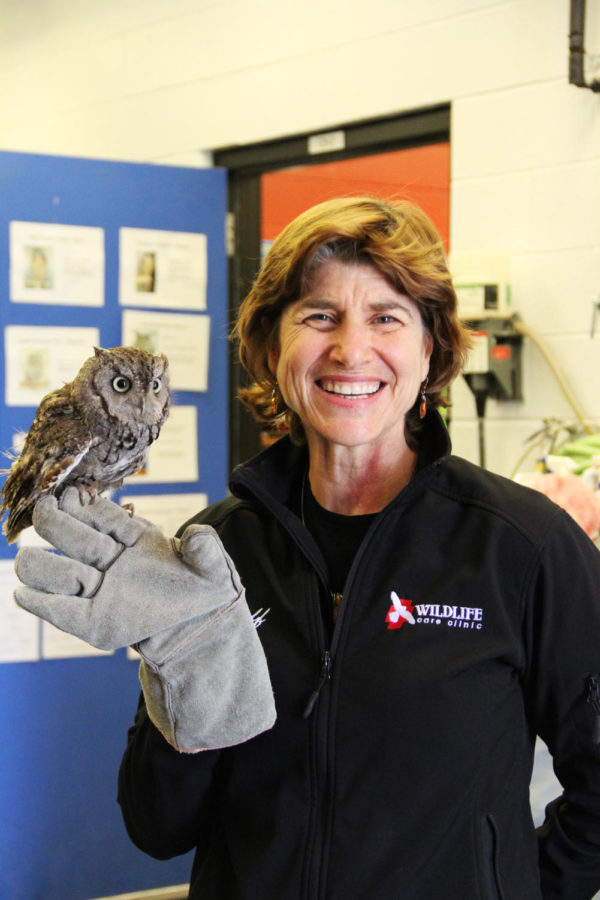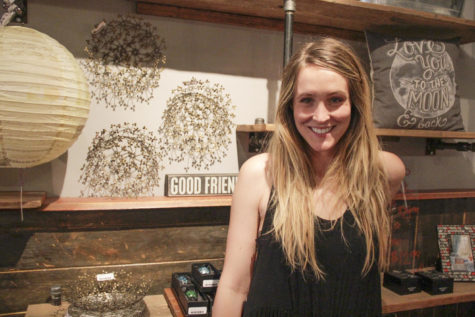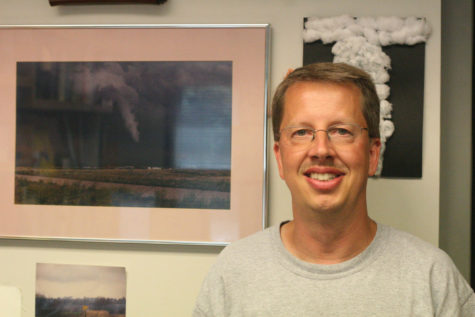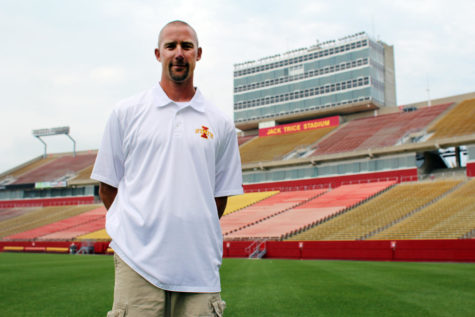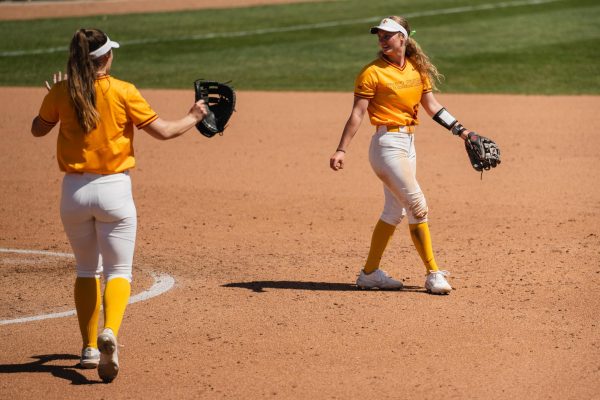One-on-One with Bianca Zaffarano
Denisha Mixon/Iowa State Daily
Dr. Bianca Zaffarano, director of Iowa State’s Wildlife Care Clinic, poses with one of her screech owls. Zaffarano has been working with wildlife for 20 years and has been with Iowa State’s clinic for about six years.
July 16, 2014
Bianca Zaffarano is the director of the Wildlife Care Clinic at the College of Veterinary Medicine. She is also the section leader for primary care, which takes care of outpatient procedures for pets. Zaffarano graduated from Iowa State in 1986 and has worked with wildlife and exotic animals for 20 years.
What made you pursue veterinarian school?
I always wanted to be a veterinarian. I can’t remember a time when I didn’t. I think my mother instilled in me a great love of everything nature and animal from a young age. And I may have been misguided thinking veterinarian medicine. I thought maybe that I was going to study the tropics. That’s something zoologist do and not veterinarians usually. So I might have misunderstood where I should go, but I think I was led to the right thing anyways. I think it was something that was felt when I was just a little kid. It was just something that always drew me there.
I remember going to Veishea as a young child, and they used to have a cow where they cut a whole in the abdomen and you could look inside. It was like a window into her belly. It sounds gross to some people but for me, it was absolutely fascinating. And that was the exhibit that I wanted to see was the veterinarian exhibit as a young child. So I can’t remember a time when I did not want to be one. My mother has a huge love of nature and animals. I think she just transferred that to most of her children — she had six, so I think we all got some of that.
What’s a typical day for you as a director?
It can be highly variable [in what] I see, along with the other doctors in my area. I will see dogs and cats on any given day. I will perform surgery on any given day. I will see any kind of exotic animal that makes an appointment. And so I can see a cat one hour, a dog the next minute, a hedgehog, and then a hamster, and then a macaw, and then a pop-belly-pig, and then a swan and then wildlife is constantly pouring through the doors through us to the Wildlife Care Clinic. The staff is undergraduate students and they kind of man the place. Their job is to do triage, which means they look at them and decide where they go. And then they bring them and put them under my face or my intern. We have to asses them and see if they can be repaired and rehabilitated and sent back to the wild. It’s highly varied, which is what I like about it. It’s not the same thing everyday — it’s not the same procedure, it’s not the same old vaccination. It’s highly variable and a lot of times really challenging because it’s sometimes unfamiliar species you don’t know much about.
What do you fear the most?
I know the cases that I get nervous about is birds that have respiratory disease because their whole body is about breathing. If a part of it is affected, it can affect the entire animal and they can be really, really sick before they even come in our door, and so then it’s a real uphill battle. It’d be like you being real sick for four weeks and not eating anything and then deciding it’s time to go to the doctor. By the time we see them, they’re really critical and oftentimes even putting our hands on them can kill them from the stress, so that’s highly stressful.
What was your worst experience working with animals?
The things that are really troublesome are for instance the eagles with lead poisoning and things that might have been prevented, but it’s human involvement and intervention that has helped to cause trauma to the animals. I guess that’s one of the hardest things. I think other things like illegally imported exotic pets — you know, people want to have something different, but they don’t really know enough about them so they bring them into captivity and then they die a slow and sad death from being in captivity or not having the right food. That kind of stuff is the stuff that really troubles me.
Have you ever had any animals escape?
Yes. Sometimes they are healthier than we think they are and they are ready to fly away and we are not quite sure about that yet, but they are bound and determined. So yeah, we have had a couple of escapees, but it’s rare. Usually it’s baby birds that say all of a sudden, “Oh yeah I can fly,” and they get away from us and they get up into the rafters, but we always get them back. It’s hard because we have to get ladders and nets and things like that, but not so many escaping outside. My staff told me about a bird that went from one roof to another roof and then back again and it was a baby and it wasn’t yet ready to go, but he thought he was and he came back to us in the night. Other than the little teeny critters that might get out of our hands — we take a pretty close responsibility for those guys so there are not many that happen. Usually it happens if they are ready to go before we know it.
What do you enjoy the most?
There are so many things that are wonderful about this profession, I guess seeing an animal, particularly in the wildlife, successfully rehabilitated and then sending them back out into the wild. We had Dean [Lisa] Nolan … and the assistant provost join us in the release of two eagles. I think they both had lead toxicity and we treated them successfully so they didn’t die and then we all went out to McFarland Park and the dean actually got to do this release and just see it fly away and it circles around a couple times as if to say thank you and then it goes away. And those are wonderfully exciting uplifting events. Those are phenomenal.
I think also there’s real innate intelligence in animals and I do really feel that most of them understand when you are trying to help. I know that sounds corny, but you can see it in their eyes. Some of the birds, I have a real fondness for crows … they’re really misunderstood birds, but they’re highly intelligent. When somebody brings a crow in, you can just see it in their eyes when you are trying to help. Not just crows, anything really. There’s something wonderful about that.
The other thing that’s really fun, especially with the wildlife clinic, is knowing that these kids who go out and they do programs with our creatures that can’t be released anywhere, they would have been dead a long time ago, but they have a permanent safe home where they’re fed and they live much longer with us than they ever would out in the wild, and they go and we have them go to give talks for kids. Just seeing the enthusiasm of the children learning about some of these creatures, like our opossum his name is Ernie … and he has been wonderful because most people think of opossums as creepy looking things.
You really see the better side of humanity because people will stop for an injured [animal]; name it you know — turtle smushed in the road, baby bunnies in a nest, a hawk in a field or a deer — they will stop, they will do everything they can to capture that and bring it to get help. To me, that’s rewarding because that shows a better side of human beings, so we get to see that a lot, which is kind of cool.
How long have you been the director of the Wildlife Care Clinic?
We moved back here from Kentucky almost six years ago now, so about six years.
How do you think the Wildlife Care Clinic benefits Iowa State?
I don’t know how many people really know it exists, but we are in the process [of getting awareness] … It’s been here for 30 years and the remarkable thing is that it has been sustained only by the good will of the veterinary college and donations and that’s the only way that we are able to take care of these animals.
We’re trying to start a program where we have involvement from other parts of the university. Right now [we have] undergraduates from campus — they’re not veterinary students — and we have a lot of volunteers from the community, not just Iowa State but from the city, that volunteer to come in and take care of animals. We’re trying to start a program with, well this is a vision and it hasn’t gotten anywhere yet. But we’re trying to do this with natural resource and environmental management and then we have another wildlife place starting outside of Boone and we’re trying to get some type of internship going between campus and [the veterinary college] and there to do more collaborative stuff.
Is the Wildlife Care Clinic getting renovated?
It’s the hope and vision to have the facilities renovated. We’re really here by the good graces of the veterinary college because we aren’t an income-generated area — a matter of anything, we’re probably in the red. I just recently had a discussion with a few people that have an interest in making it better than it is now and I’m hopeful that that will happen in the not too distant future.
How could Iowa State help the Wildlife Care Clinic?
Our biggest chronic thing with any nonprofit is finances and with financial backing we, I think, could do wonderful things to solidify a program between departments that would be pretty exciting and we’re starting to get involved in veterinarian students now too. We do have an internship through the college now that supports a veterinary doctor, recent graduate coming to test their doctor feet out, with wildlife. I think that it has potential to cross disciplines.
It’s a little bit hard because we’re isolated out here. We’re kind of this isolated place but it would be nice if we could integrate more with different departments on campus and become sort of an interdepartmental effort of interest and research. I think that there’s just a lot of potential. I think there’s untapped potential.
What type of exotic animals do you treat at the Wildlife Care Clinic?
We have seen and we have brought in a bobcat, we had a beaver that was stuck in a drain pipe in Des Moines. Occasionally a baby fox would slip through the cracks. We see a whole lot of the things that you would expect like opossums and squirrels and turtles. We had a couple of white pelicans, those huge birds that were in last year. They had both been injured probably by power lines. They found a home in San Francisco Zoo if I am not mistaken, they went out to California to a wildlife place out there. Sometimes we have birds that have flown off course like the snowy owl, big white ones. We don’t see them very often here. For some reason, they’re migrating way off course or blown off course or they’re lost and they’ll land here. Just different species of birds. We have not seen any baby bears and things like that — we are not equipped to do that. We do see a lot of white tailed deer, we see a lot of rafters, so the eagles are very cool. We also see a lot of owls and a lot of hawks, and the little smaller birds of prey.
Whats your favorite animal?
There are so many unique things with each kind of animal. With each breed and each species, there’s so many phenomenal adaptations that they each have, it’s hard to have a favorite, it truly is … the swans are very cool, just elegant beautiful birds. We had Elaine in here not too long ago, [he] got tangled in a fishing wire and had a hook. Somebody was probably fishing in Lake LaVerne, so there was a hook and fishing line all wrap around [his] leg and through [the] foot and around [his] back side. But [he] was very gentle and very calm about being treated. I think they are elegant birds.
I think it’s really hard to say. Eagles are regal and humbling because they’re so enormous. Pelicans are just clowns and owls think they’re big, they have a little Napoleon syndrome. They snap their beaks at you and they say “Stay away.” So they all have their individual personalities and it’s very difficult to say that this is my favorite.
What do you enjoy during your free time?
There really isn’t much free time. I love anything outdoors, love traveling to different parts of the world. I love photography and obviously wildlife. I like yoga and I used to run a lot before my knees became old. Bicycling, hiking and skiing — those are all things that I love to do. I’d be a professional traveler and photographer if I could, photographer of wildlife probably.
Are there any things that we can do to help wildlife?
One thing is don’t throw your food out of the window on the highway because that is when animals come near the highway to eat it and then they get hit. So when you’re throwing the rest of your McDonald’s out the window or something like that and you think, “Oh somebody can eat this.” Yeah they do and then they come and they get hit, so that’s one of the big things.
If they see injured wildlife, first of all be careful, don’t get hurt and remember they can still be dangerous even though they are not aggressive. It’s best to probably call the Department of Natural Resources or something like that if it’s an animal that you can’t safely get into a box.
Usually baby bunnies don’t need to be rescued. We have a lot of people bring in baby bunnies and they are not abandoned, the mamas don’t sit with them during the day, they just come back at night. People find the nests and think “Oh, they’re abandoned” because they don’t see the mama and they scoop them all up and they bring them in. They have less than a 50 percent chance of survival if they do that and they have better survival if you leave them.
When people have questions, it’s best just to call the wildlife clinic and find out what to do with it before they touch it.

